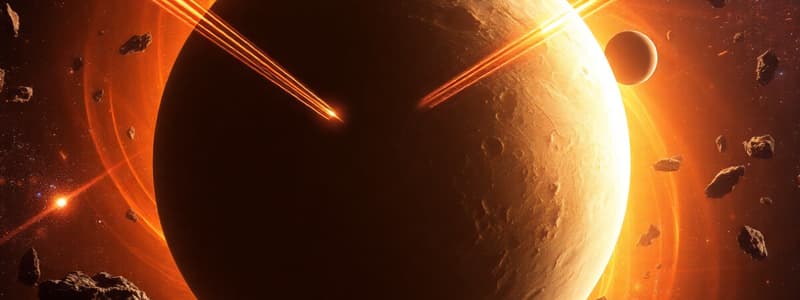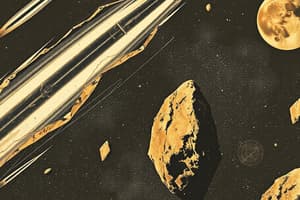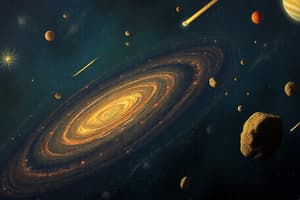Podcast
Questions and Answers
What primarily constitutes the nucleus of a comet?
What primarily constitutes the nucleus of a comet?
- Dust particles blown away from the nucleus
- A dark, dirty snowball of ice, dust, rock, and gases (correct)
- A halo of gas and grit
- Primarily plasma reaching 100 kilometers long
What is the key difference between meteors, meteoroids, and meteorites?
What is the key difference between meteors, meteoroids, and meteorites?
- Meteors are in space, meteoroids are in the atmosphere, and meteorites are on Earth.
- Meteors are metallic, meteoroids are rocky, and meteorites are icy.
- Meteoroids are in space, meteors are in the atmosphere, and meteorites are what's left after hitting Earth. (correct)
- Meteors are large asteroids, meteoroids are small asteroids, and meteorites are dust grains.
How did the OSIRIS-REx mission gather information about the asteroid Bennu?
How did the OSIRIS-REx mission gather information about the asteroid Bennu?
- By landing on the asteroid and conducting on-site experiments.
- By scooping up a sample of dust and rocks from the asteroid's surface. (correct)
- By crashing into the asteroid to analyze its debris.
- By orbiting and deploying rovers to the surface.
Where can most asteroids be found in our solar system?
Where can most asteroids be found in our solar system?
What distinguishes long-period comets from short-period comets?
What distinguishes long-period comets from short-period comets?
Why are asteroids valuable to scientists studying the solar system?
Why are asteroids valuable to scientists studying the solar system?
What happens to a meteoroid to be classified as a meteor?
What happens to a meteoroid to be classified as a meteor?
Which NASA mission has studied both the asteroid Vesta and the dwarf planet Ceres?
Which NASA mission has studied both the asteroid Vesta and the dwarf planet Ceres?
If a space rock travels through the atmosphere and impacts the ground, what is it called?
If a space rock travels through the atmosphere and impacts the ground, what is it called?
Which part of a comet is described as the halo of gas and grit that surrounds the nucleus?
Which part of a comet is described as the halo of gas and grit that surrounds the nucleus?
What are asteroids primarily made of?
What are asteroids primarily made of?
What is the Kuiper Belt?
What is the Kuiper Belt?
What is unique about the NEAR Shoemaker mission?
What is unique about the NEAR Shoemaker mission?
Which of the following is a characteristic of the tail of a comet?
Which of the following is a characteristic of the tail of a comet?
What evidence is available to study asteroids?
What evidence is available to study asteroids?
What determines whether a comet is classified as a short-period or long-period comet?
What determines whether a comet is classified as a short-period or long-period comet?
What is the Oort Cloud?
What is the Oort Cloud?
What is the primary source of meteoroids?
What is the primary source of meteoroids?
Why is the tail of a comet so visible?
Why is the tail of a comet so visible?
How are asteroids formed?
How are asteroids formed?
Flashcards
Kuiper Belt
Kuiper Belt
A wide disk beyond Neptune's orbit where many comets reside.
Oort Cloud
Oort Cloud
A sphere-shaped outer edge of the solar system, far beyond the Kuiper Belt, home to long-period comets.
Comet Nucleus
Comet Nucleus
The solid, central part of a comet, composed of ice, dust, and gas.
Coma (of a comet)
Coma (of a comet)
Signup and view all the flashcards
Comet's Tail
Comet's Tail
Signup and view all the flashcards
Asteroids
Asteroids
Signup and view all the flashcards
Meteoroid
Meteoroid
Signup and view all the flashcards
Meteor
Meteor
Signup and view all the flashcards
Meteorite
Meteorite
Signup and view all the flashcards
Study Notes
Comets
- Comets are mainly located far out in the solar system.
- Short-period comets reside in the Kuiper Belt, orbiting the Sun in less than 200 years.
- Long-period comets are found in the Oort Cloud, approximately 50 times farther from the Sun than the Kuiper Belt.
- A comet with the longest orbit takes over 250,000 years to complete one solar orbit.
Comet Anatomy
- Nucleus: A small, frozen core made of ice, dust, grit, rock, and gases.
- Coma: The halo of gas and grit surrounding the nucleus.
- Tail: The most visible part of a comet with two types
- Dust tail: Composed of dust particles blown away from the nucleus.
- Ion or gas tail: Made of plasma, extending up to 100 kilometers long.
Asteroids
- Asteroids are also referred to as minor planets.
- They are remnants from the solar system's formation, approximately 4.6 billion years ago.
- Asteroid sizes vary, ranging from hundreds of miles in diameter to as small as pebbles.
- There are 1,281,037 known asteroids
- Most asteroids are in the main asteroid belt between Mars and Jupiter.
- Asteroids consist of different rock types, some containing clays or metals like nickel and iron.
Asteroid Research
- Asteroids provide information about the history of planets and the Sun due to their simultaneous formation.
- Meteorites, or small asteroid fragments that pass through Earth's atmosphere, are useful for asteroid study.
- NASA missions have studied asteroids, including the NEAR Shoemaker landing on Eros in 2001.
- The Dawn spacecraft studied Vesta and Ceres in 2011.
- In 2016, the OSIRIS-REx mission studied and collected samples from asteroid Bennu.
Meteoroids, Meteors, and Meteorites
- Meteoroids: Space objects ranging from dust grains to small asteroids, known as "space rocks".
- Meteors: Fireballs or "shooting stars" that occur when meteoroids burn up in Earth's atmosphere.
- Meteorites: Result when a meteoroid survives atmospheric entry and impacts the ground.
- Meteoroids can originate from asteroid collisions or comets.
Studying That Suits You
Use AI to generate personalized quizzes and flashcards to suit your learning preferences.




